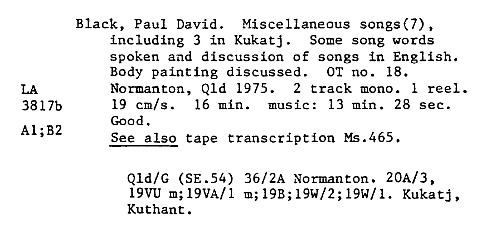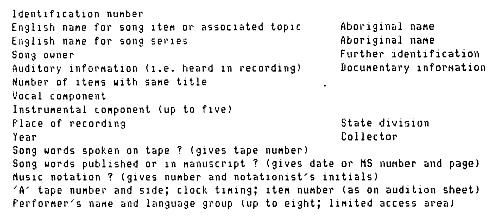Collection of ethnomusicology and language recordings
Case Study: Australian Institute of Aboriginal Studies, Canberra, Australia.
(a) Collection
The Institute's collection comprises over 8,000 hours, 70% of which is speech, 30% music. Material collected by anyone awarded a research grant by the Institute (including Institute staff) is deposited as a condition of such a grant; deposits from other sources are also welcomed. A range of restrictions on the use of and access to recordings is maintained by the Institute and recorded on each contract of deposit.
(b) Cataloguing Staff
Cataloguing is the responsibility of two graduate staff, both with field work experience, and one typist. All have other duties (see gi).
(c) Catalogue
Within the Institute, a card catalogue is maintained, supplemented by access from a computer terminal inside the Institute to an on-line data base. Lists of new accessions and catalogues to coherent sub-collections are published -some in microfiche format.
(d) Catalogue System
A card catalogue is used, with entries being complemented by audition sheets (which provide a detailed, timed analysis of the contents of the tape as heard), transcripts, records on restrictions etc. (see gii). Part of the collection has been catalogued using IQL (Interactive Query Language) as a pilot project.
(e) Indexes
The manual card catalogue is indexed by location of recording, song titles and series, languages and subject codes; a file of informants' names is maintained separately, and is accessible to approved users only. Under IQL, any information field contained within a catalogue entry may be the basis of an enquiry.
(f) Examples
i. The catalogue card, reproduced below is filed alphabetically under collector's name. Marginal notations give tape number and restriction indicators. Library codes indicate origins (e.g. Qld/G meaning Queensland, Gulf area), content (20A/3 meaning body painting; 19W/2 meaning discussion of song and song words), and style of performance (19VU meaning unaccompanied singing by one man, 19B an elicited performance etc.). Language names are listed at the end of the codings.

ii. The fields available for a computerised catalogue record under IQL pilot project are shown in figure 7.

Figure 5 illustrates what a full catalogue entry printed out by the computer looks like.
 Figure 5
Figure 5
(g) Comments
i. The number of cataloguers has not proved large enough to keep pace with accessions currently estimated at circa 1,000 tapes per year. It is thought that additional clerical and typing staff could help; schemes for training Aboriginal cataloguers have also been initiated.
ii. The use of codes to standardise variant spellings of language types and to delineate 'tribal areas', the importance given to the question of restrictions on access to recordings, the provision of a catalogue field label recognising the Aboriginal concept that songs are owned not composed, and other details visible in the examples are all conspicuous reminders of the difficulty of documenting material from different cultural traditions. The IQL format developed at AIAS is a pragmatic response to these difficulties.


